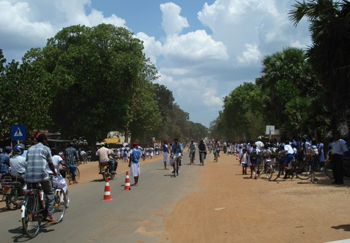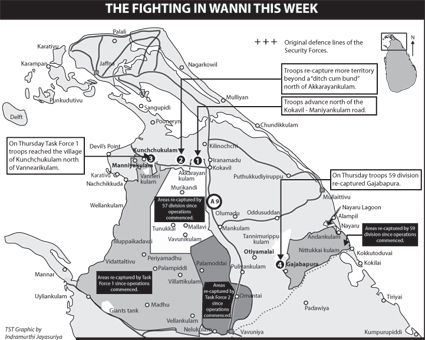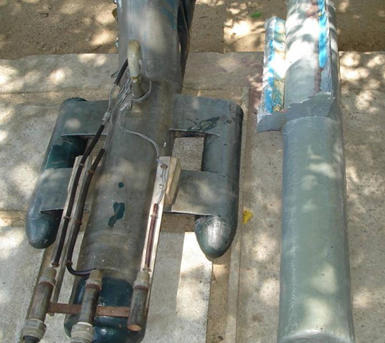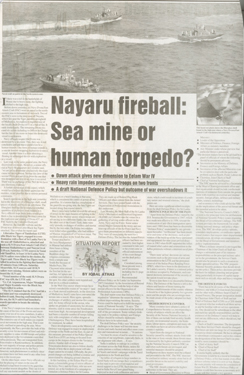Besides confronting Tiger guerrillas, troops in the battlefields of Wanni have come up against another formidable "enemy," the incessant rains, with the northeast monsoon in full swing. Almost every area is waterlogged and muddy.
Troops are engaged in constructing a roadway beyond Mannar, towards the frontlines. This is not only to facilitate movement of supplies, both food and military needs, but also to enable casualties to be brought to the rear areas for evacuation by helicopter. The new odds, no doubt, have to some degree slowed down the troop advance. However, they have been engaging the guerrillas on a number of fronts. Air Force bombing raids through Kfir multi-role combat aircraft and Mig-27 ground attack aircraft have been minimised due to weather conditions. However, Mi-24 helicopter gunships continue to provide close air support to the troops in the battle zones.
 |
| Dharmapuram, on the road between Paranthan and Mullaitivu has become a hive of civilian activity replacing Kilinochchi. |
Kilinochchi remains devoid of civilians. Activity has now shifted to Dharmapuram, a town 13 kilometres away. It is located on the Paranthan-Mullaitivu Road. In marked contrast to any festivity there, hectic arrangements are under way by residents of the Jaffna peninsula to celebrate Deepavali, the Hindu festival of lights tomorrow.
One of the ill effects of the northeast monsoon is the vast number of soldiers getting drenched. They are compelled to endure hardships of remaining in their wet uniforms with soggy socks and boots for days. It is only in some areas that shelter, in the form of abandoned buildings, is available. Besides other medical supplies, stocks of coriander are also being sent to the frontlines for use by soldiers to avoid catching colds. They usually boil it and consume the water. Here again, the non availability of drinking water has led to large stocks of bottled water being sent from Colombo.
This week, Army engineers were busy converting cargo containers into a different kind of "hot houses." Equipped with power generators, these containers are installed with laundry dryers and heaters. They are to be used to dry uniforms and other clothing of troops. A flat bed trailer moved the first such container last Friday for use by troops of the Army's 574 Brigade. They are part of the 57 Division, which has met with stiff resistance in its attempts to advance towards Kilinochchi, until recently the centre of political power of the Tiger guerrillas. More such cargo containers, now being converted into "hot houses," are to be moved to other parts of the Wanni battlefields.
Troops of the Army's 57 Division remain locked in battles with guerrillas ahead of Kokavil, a town on the A-9 highway located 22 kilometres south of Kilinochchi. Others have advanced in a northerly direction towards Kilinochchi, ahead of the Terumurukandi-Manniyakulam road. West of their location, this week, troops regained control of stretches that lay just beyond Akkarayankulam. This is by breaking through a lengthy "ditch cum bund" the guerrillas had constructed. In what is easily some of the fiercest battles since Eelam War IV began, both sides suffered heavy casualties in the fighting in this area on October 18 (Saturday) and the next day.
On Thursday, the Army's Task Force 1 (precursor to a 58 Division), overcame guerrilla resistance to reach the village of Kunchchukulam. They have seized an extent of some six square kilometres. This village is located north of Vannierikulam, which they re-captured earlier. This advance has made the coastal village of Nachchikuda more vulnerable. It was here that the guerrillas operated a major Sea Tiger base. With the fall of Vidattaltivu (further south of Nachchikuda), the guerrillas moved all logistics to Kilinochchi. However, they have successfully resisted a troop advance so far.
 |
Also on Thursday, troops of the 59 Division operating in the Weli Oya sector expanded the areas under their control by re-capturing Gajapura. The late Gen. Wijaya Wimalaratne, a veteran soldier, set up camp in this area in 1984 to provide protection for civilian settlements in Weli Oya. This settlement scheme followed the previous Padaviya settlements. Since he, as a Colonel, then commanded the first battalion of the Gajaba Regiment, the area was named Gajabapura. It was previously referred to as Ceylon Theatres Farm since the company was one of many involved in agricultural projects in the area. It is located southeast of the village of Ottiyamalai.
Gajabapura was lost during the Wanni debacle in 1999. This was together with a vast swathe of land east of the A-9 highway. Troops advance northwards, in the direction of Mullaitivu has met with considerable resistance from the guerrillas.
A matter of some concern for the defence and security establishment came on Wednesday. Tiger guerrillas successfully infiltrated the secure high security zones of the northeastern and northern seas to attack two cargo ships.
It was just before dawn on Wednesday when two human torpedoes approached the cargo vessels MV Nimalawa and MV Ruhuna that had weighed anchor in the seas off the Kankesanthurai (KKS) port. This port is part of SLNS Uttara, the Navy’s main installation in the Jaffna peninsula. It adjoins the Security Forces Headquarters (SFHQ) in Palaly.
According to Navy sources in KKS, MV Nimalawa had arrived on Tuesday with a cargo of food items. Until Tuesday evening, some 400 tons had been unloaded. It had thereafter moved away from the port area to weigh anchor in the outer harbour area and to return next morning to unload the remaining cargo. MV Ruhuna had carried a consignment of cement. Some 1,000 tons had been unloaded before it moved out to weigh anchor near MV Nimalawa.
Between 5 and 5.15 a.m. two "human torpedoes" headed towards the two cargo vessels. They had used two fibreglass contraptions. The two suicide bombers exploded themselves. One of these contraptions (or a floating device) was destroyed and the Navy later recovered the other. In the latter, the Navy found a Global Positioning System (GPS). There was a gaping hole, six foot in diameter, in MV Nimalawa and it had to be towed out. The remaining cargo of cement was spoilt by the seepage of water.
There was considerably less damage to MV Ruhuna where some glass panes in the upper deck had been shattered. A quantity of food cargo was spoilt by sea water. There was also water seepage to the engine room. However, Navy officials said the vessel could sail. Official Government web sites run by military officials claimed on Wednesday morning that one of the cargo vessels was sinking after the Tiger guerrilla attack. The report was withdrawn barely an hour after the incident. Contrary to their claims, there were only fears of the vessel being sunk after the six-foot diameter hole led to fears that the ship may list heavily.
Some senior Navy officials opined that the Tiger guerrillas wanted to destroy the cargo vessels as a part of a major plot. This was with the intention of fronting one of their own cargo vessels when the Government or the private sector sought to purchase replacements. However, the claim appeared far-fetched. It would require immense capabilities on the part of guerrillas to operate from several fronts to offer different vessels surreptitiously.
 |
| Part of the contraption used by Tiger guerrilla “human torpedo” during the attack on a Navy Dvora fast attack craft in March this year. It was then recovered by the Navy. |
Others said one or two vessels would have also carried military cargo and the guerrillas therefore wanted to destroy them. The Navy insisted that there was no military cargo on the two vessels.
A more plausible reason came from intelligence authorities in the north who were probing the incident. They believe the guerrillas may have mistakenly attacked the two cargo vessels instead of MV Lanka Muditha. Only days earlier, this vessel had reached KKS with a complement of military cargo including ammunition and artillery shells. It had completed discharging by the time the incident occurred.
To these intelligence authorities a much bigger concern was how the "two human torpedoes" managed to infiltrate the naval cordon to reach KKS, a key point in the high security zone in the sea. Since the troops were operating on land on the western part of Wanni forcing guerrillas to minimise or even cease operations in the seas off that area, the critical question is how the "human torpedoes" managed to reach the seas off the Navy's main base at KKS. They believe the guerrillas ventured into the deep seas from the general areas near the north-eastern coastal village of Vettailaikerni.
The suicide bombers, they suspect, were on board a fishing trawler with the fibreglass contraption being towed until they reached the deep seas off the Jaffna peninsula. Thereafter, they infiltrated a naval cordon to reach the waters barely a few hundred metres off the Navy's main operational base in the peninsula. "The fact that they succeeded in infiltrating a high security zone in the seas, moving freely for a long distance to carry out an attack, is very worrying. It only underscores the need for further measures to make the HSZ (High Security Zone) foolproof," said an intelligence source in Jaffna speaking on grounds of anonymity.
Evidence that the guerrillas were using "human torpedoes" with a new contraption surfaced in March, this year. It was following an attack on March 22 on a Navy Dvora fast attack craft. Here are excerpts of what The Sunday Times (Situation Report - March 23, 2008) said about the incident:
 |
| The Situation Report March 23, 2008 |
"If there was a lull in the battlefields of Wanni due to heavy rains, the fighting shifted to the high seas."Before dawn yesterday, six Navy Dvora Fast Attack Craft (FAC) were on patrol in the north-eastern seas in formations of two each. Two of the FACs were in the deep seas off Nayaru, which lies near the Tiger guerrilla stronghold of Mullaitivu. An explosion engulfed one of the locally built Dvora (437) in a ball of fire. It sank immediately. The remaining Dvora rescued six sailors including its Officer-in-Charge but the fate of ten more on board the destroyed vessel is not known.
"Navy officials suspect the Dvora was destroyed by a sea mine. This, they say, is not conclusive and add that it could even be a human torpedo in the form of human torpedo is a suicide bomber strapping explosives to ram a vessel. Another form is a diver directing a floating or submerged device with explosives at a vessel…………"
A fact that was lesser known came days after the incident. Navy vessels scouring the seas off Nayaru discovered that the attack on the Dvora fast attack craft in March this year, was carried out using the contraption (or device) they suspected. See photograph of this contraption on this page. A video of practice runs by guerrillas, seen by The Sunday Times, shows that the contraption or device is partially submerged when a suicide cadre is atop. An outboard motor powers it, which is at full throttle when it speeds towards a target. For some unexplained reason, only one of these contraptions or devices was destroyed when two "human torpedoes" exploded hitting the two cargo vessels on Wednesday morning. The other remained and was seized by the Navy.
Whilst troops in the Wanni continue to mount pressure on the guerrillas, despite their strong resistance, the Government has stepped up the recruitment drive for the military. Groups of recruits are now under training and are to be deployed shortly. In the meanwhile the Government is dealing firmly with deserters. Military Courts Martial have so far sentenced 1059 soldiers to jail terms ranging from three months to a year. A further 5765 who were arrested are now facing Courts Martial. Centre Commandants of the various regiments have been given the power to hold such a Court Martial against troops who are arrested.
Whilst the arrests were under way, the Army urged soldiers who had left their positions to surrender. A total of 5035 gave themselves up after heeding this call. Following disciplinary inquiries, these soldiers are now being re-deployed in battle areas.
In Tamilnadu where there have been mounting protests over developments in Sri Lanka, a Tamil newspaper in Chennai has reported what it calls an interview with Velupillai Prabhakaran, leader of the Liberation Tigers of Tamil Eelam (LTTE). Nakkeeran says the interview was reportedly obtained via e-mail and adds that questions have been answered by the guerrilla leader "in consultation with Nadesan," head of the Political Wing. A Tamil newspaper in Colombo reproduced the lengthy interview Wednesday.
Responding to a question on the assassination of Major General (retd.) Janaka Perera, Mr Prabhakaran is quoted as saying "whenever there has been similar incidents in the past, the LTTE is always accused. This is a general practice. There is a dispute within the military."
However, the LTTE has never admitted to carrying out political assassinations. A few examples are the killing of then President Ranasinghe Premadasa, then Minister Gamini Dissanayake, a candidate at the 1994 presidential elections and more recently Minister Jeyaraj Fernandopulle. The only exception perhaps was the assassination of one time Indian Prime Minister, Rajiv Gandhi. It was owned up during his only news conference in Wanni in April 2001, shortly after the Norwegian-brokered Ceasefire Agreement of 2001. Here again, it was in response to a series of questions posed.
Mr. Prabhakaran is quoted as saying that the troops re-capture of Kilinochchi is a "day dream of President Rajapaksa." However, the President made clear on Friday to Opposition UNP leader Ranil Wickremesinghe that troops would soon regain control of Kilinochchi. He was quite confident it was only a matter of time. |
